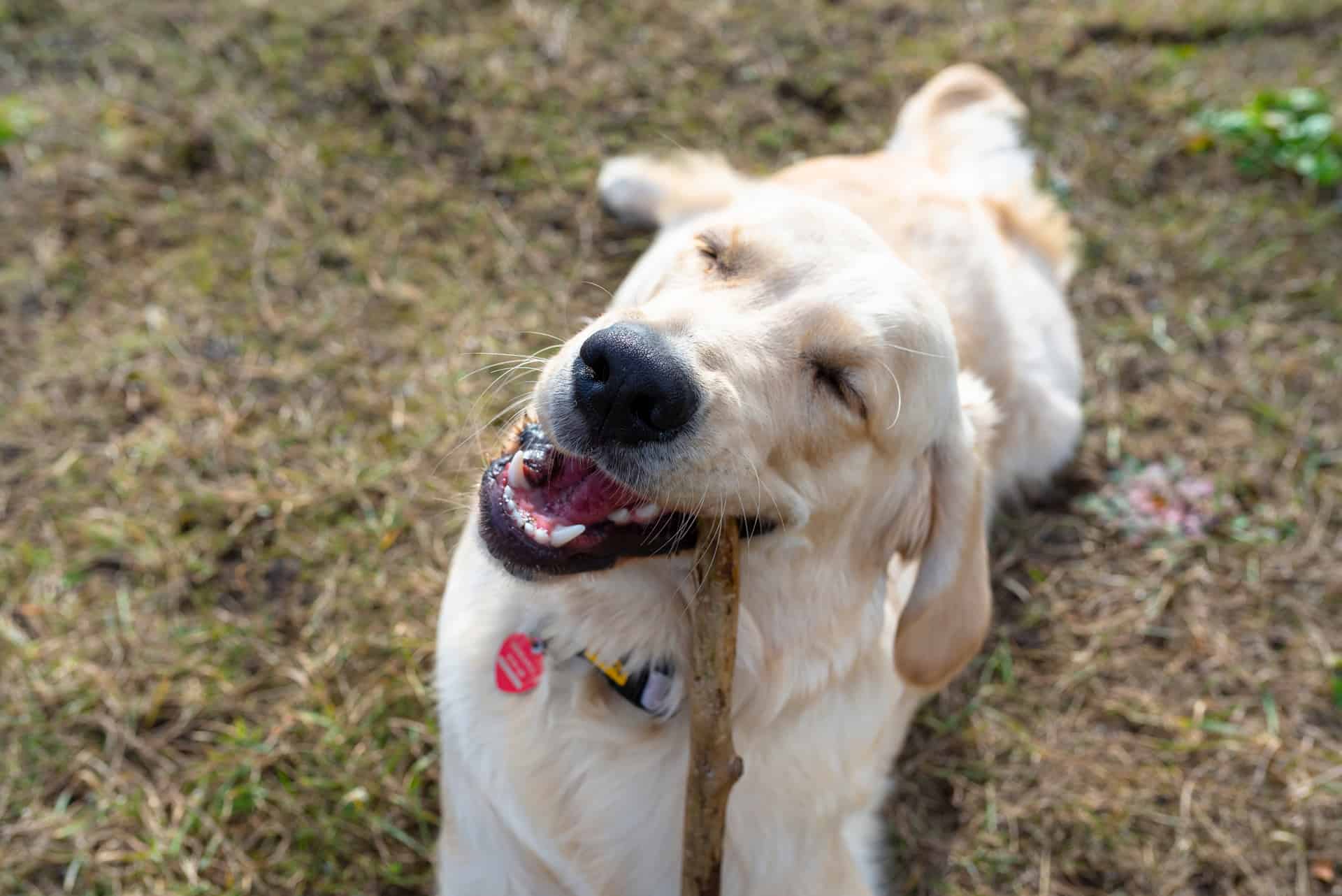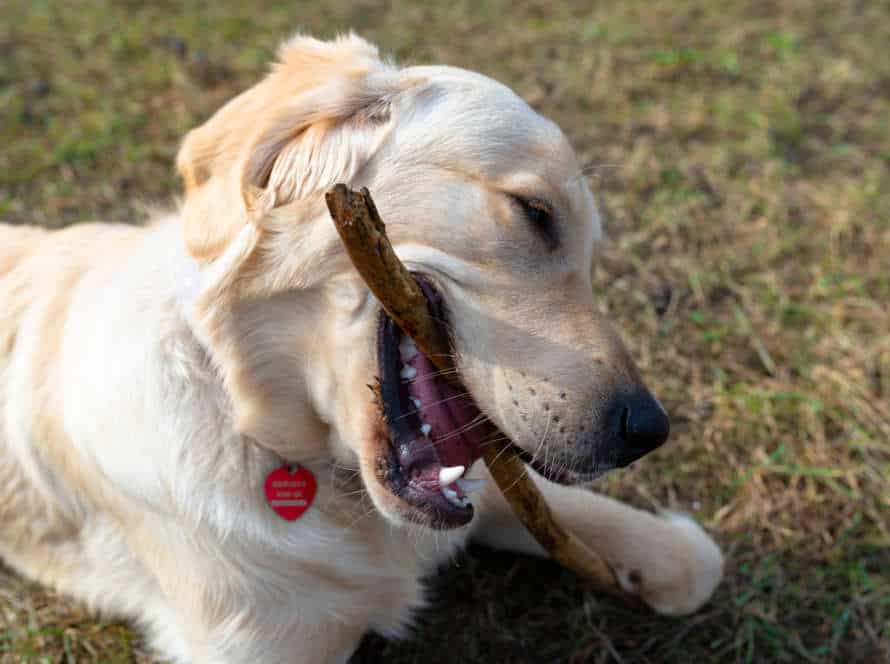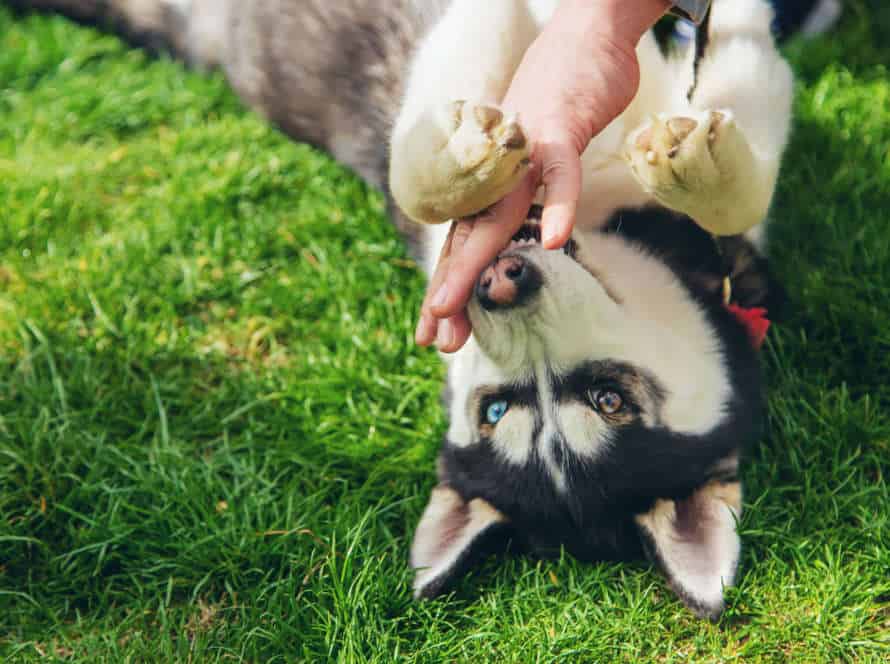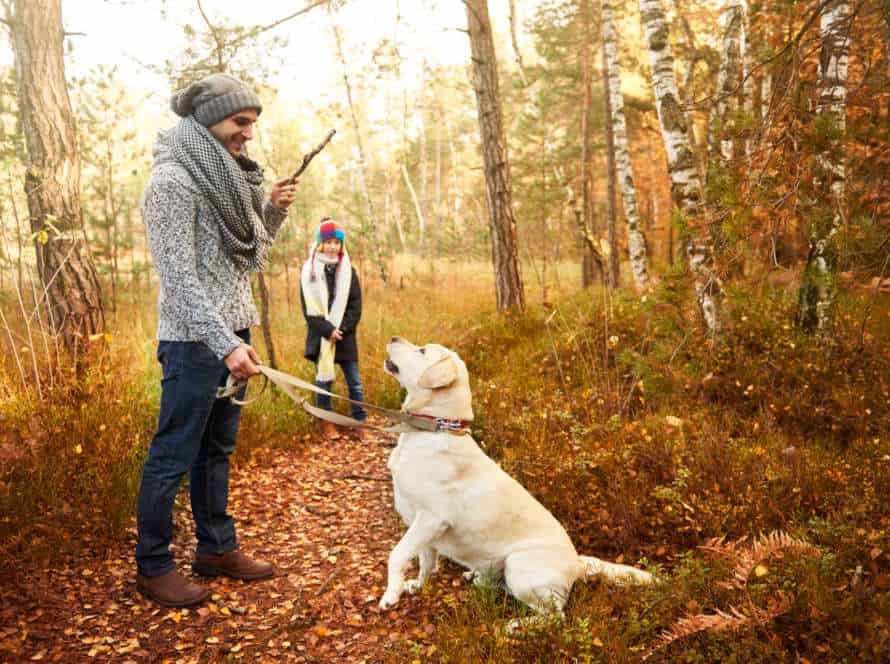The Importance of Consistency in Teaching Bite Inhibition
Consistency is essential for teaching bite inhibition to puppies. This training teaches them to control their bite and stops them from becoming aggressive as they grow.
These are the key points to remember:
- Consistency: Utilize the same verbal cue, like “ouch” or “too rough” every time and instantly stop play when a puppy bites.
- Positive Reinforcement: Praise the puppy when they obey the verbal cue and play gently instead of biting.
- Socialization: Expose your puppy to different people, pets, and environments regularly.
By being consistent in teaching bite inhibition, you can help your puppy form good habits and avoid future behavior problems.
Pro-tip: Use positive reinforcement like treats and verbal praise to reward your puppy’s good behavior.
Understanding Bite Inhibition
Teaching bite inhibition to dogs is vital. It can stop hazardous circumstances from occurring. A dog’s capability to sense and practice bite inhibition is necessary for them to interact safely with humans and animals. Teaching this is difficult, however being persistent and patient is crucial. This article will discuss the procedure of training bite inhibition and the significance of staying consistent.
Definition of Bite Inhibition
Bite inhibition is the ability of an animal to control how hard it bites. This is important when training puppies or dogs, as it can prevent aggressive behavior and biting incidents in the future.
For consistent training, use one command, such as “no biting” or “gentle“, when teaching your dog not to bite. Reward gentle play with treats, praise, or petting. Redirection or distraction can be used to discourage biting behavior. Avoid physical punishment and negative reinforcement, as these may cause fear and aggression in your dog.
Why is it important to teach Bite Inhibition?
Bite inhibition is when dogs control the strength of their bite. This is essential for socialization and interaction with people and other dogs.
Benefits include:
- Prevention of aggression. Dogs with good bite inhibition are less likely to bite hard and cause injury, even in stressful situations.
- Safe play. Dogs with good bite inhibition can play safely with other dogs and humans without causing harm.
- Easier training. Bite inhibition encourages dogs to learn basic obedience and socialization skills easily.
To teach bite inhibition, consistency and positive reinforcement are key. Use commands such as “gentle” or “easy” and immediately stop play or interaction when the dog bites too hard. Reward the dog when they exhibit gentle behavior through treats and praise.
Pro Tip: Start teaching bite inhibition early in a puppy’s life for good socialization and positive behavior habits.
Understanding the stages of development for puppies
Comprehending the growth stages of young dogs is essential for successful training. Especially when it comes to teaching bite control. By grasping these stages plus their related habits, you can give steady and efficient instruction to pups to learn how to manage the force of their bite.
Socialization stage: This period takes place between 3-14 weeks and is a fundamental time for puppies to start mastering bite control through contact with other dogs and people.
Exploration stage: Taking place from 2-4 months, this stage is when puppies become more inquisitive about their environment and start biting and chewing on things. It’s the perfect time to reinforce bite inhibition training.
Adolescence stage: Usually occurring from 4-8 months, this stage can involve going backwards in bite inhibition because of hormonal changes, so it’s important to stay regular with training.
Pro Tip: Always utilize positive reinforcement techniques, such as compliments and treats, to support and compensate good behavior.
The Impact of Inconsistent Teaching
Teaching bite inhibition is a must for dog training. It’s an important part of having a good relationship with your pup. But, if you’re not consistent in teaching bite inhibition, it won’t be as effective. This article will explain why consistency is key.
The Consequences of Inconsistent Teaching
Inconsistent teaching of bite inhibition to puppies can result in injury and trauma. Bite inhibition is a pup’s ability to control their bite force. Confusing a pup can lead to destructive chewing, aggression, and disrespect for boundaries.
Consistent reinforcement with positive rewards is key for successful training. Puppy owners can prevent this with consistent commands and a reward system. This promotes good behavior and a positive relationship.
Pro tip: Consistent commitment, time, and effort is essential for dog development. Always provide the same level of commitment.
The Importance of Controlling Exposure to Improper Bite Inhibition
For dog owners, bite inhibition training is key. It stops accidents and makes sure pets and humans get along. Inconsistent teaching or the wrong kind may be bad for a dog’s socialization and behavior.
Dogs not taught bite inhibition may not know that biting is wrong. This can lead to aggressive and risky behavior. Wrong or inconsistent training can also cause fear and anxiety.
Bite inhibition training and consistent teaching are vital. They shape behavior, stop potential accidents and create strong relationships.
Pro Tip: Understand your dog’s body language. If needed, seek professional help.
The Risks for Children and Other Pets
Inconsistent teaching of bite inhibition can put both kids and other pets in danger.
It’s vital to consistently teach your dog proper bite inhibition techniques, to make sure they don’t hurt others.
Inconsistent teaching can make your pup more aggressive, especially towards kids who are more vulnerable.
By consistently teaching your pup to control the force and strength of their bites, you’re making sure they can socialize with other animals and kids without causing harm.
Remember: dogs require patience and repetition when training. Consistency with positive reinforcement is important until the habit is established.
Pro Tip: Consistency is essential for successful training. Have patience and repeat the desired behavior.
Consistent Training Methods
Train your pup with consistency! It’s the key to creating good habits and behavior. Teach them to use gentle bites while playing, by having a consistent training plan. Here are some methods to help you:
- Establish a regular routine.
- Use positive reinforcement when your pup displays the desired behavior.
- Practice the same commands each day.
- Be patient and consistent in your training.
Understanding Positive Reinforcement
Positive reinforcement is a way to train. It involves rewarding desired behavior to make it happen again. Consistency is key for effective training and modifying behavior. Especially when teaching bite inhibition to puppies and dogs.
Here’s why:
Puppies learn best with repetition and consistency. Rewards for gentle mouthing and biting helps them understand what’s expected of them.
Positive reinforcement builds trust between you and your puppy. Rewards for good behavior nurture a positive relationship based on trust, not fear or punishment.
Consistency in positive reinforcement prevents confusion and frustration for your puppy. An easy-to-understand reward system makes it simpler for them to know what you want from them and what will lead to good results.
Pro tip: Always give rewards for good behavior right away. Use positive reinforcement consistently for the best training.
Reward-Based Training for Bite Inhibition
Reward-based training is a brilliant way to help your pup or young dog learn how to control its bite. Consistency is essential to ensure success and avoid any misunderstandings.
Here’s how to use reward-based training to teach bite inhibition:
- Begin by playing with your pup and let it lightly mouth your hand.
- If it bites too hard, stop playing immediately and make a loud yelp of pain.
- Then, ignore your pup for about 30 seconds after the yelp.
- Carry on the process when the timeout ends.
- Praise and give treats when your pup bites gently.
It is important to remember that bite inhibition training needs consistency. By sticking to the training method, you can guarantee that your dog will form good habits and not bite too hard during playtime.
Training Exercises for Consistent Results
Training exercises are a must for reliable results when teaching dogs bite inhibition. Consistent training is vital. Here are 3 exercises that can help:
- “Leave It” Exercise – Put a treat in your closed hand, extend it to your dog. When they sniff, lick, or paw at it, say “leave it” and close your hand. Repeat and reward your dog when they stop trying to get the treat.
- “Drop It” Exercise – Give your dog a toy or treat, tell them to “take it”. Offer another toy and say “drop it”. Reward them when they obey.
- “Touch” Exercise – Put your open palm in front of your dog. When their nose touches it, say “touch” and give them a reward. Gradually increase the distance between your hand and your dog to teach them to follow your commands without physical contact.
Be consistent with these exercises to teach effective bite inhibition to your dog.
Reinforcing Consistent Learning
Consistency is essential when teaching your dog bite inhibition. Repetition is how dogs learn, so consistent reinforcement is the key to success! Why is consistency so crucial? Read on to find out. We’ll explain how to get it done when teaching your pup bite inhibition.
How to Maintain Consistency in Training Bite Inhibition
Consistency is the key to teaching your pup good bite inhibition. Here’s how to make sure they learn and remember:
- Repetition: Keep repeating the same routines and commands to reinforce positive behavior.
- Patience: Give your dog time to learn, and reward them with treats and praise for doing well.
- Boundaries: Set clear, consistent boundaries so your pup knows what behavior is okay and what isn’t.
- Training: Schedule regular training sessions to help your pup stay on track.
Remember, consistency is key! Providing regular, constructive training will help your pup learn and remember the right behavior.
Persistence and Repetition
Persistence and repetition are musts for consistent pup learning, specifically for bite inhibition. This skill is very important, as it prevents any unintentional harm from occurring with teeth.
To reinforce this lesson:
- Utilize a single verbal cue when too hard of a bite is taken, such as “ouch” or “no biting”.
- Everyone in the house must use the same cue and respond in the same way.
- No rough play, as this increases the chance of biting.
- Use positive reinforcement like treats or words of praise when bite inhibition is shown.
- Patience and persistence is required, as it could take weeks or months.
The Role of Socialization in Bite Inhibition
Socialization is key for teaching puppies bite inhibition. It helps them learn to control their bite pressure and strength.
To reinforce learning, be patient and don’t use physical punishment. Positive reinforcement such as praising and rewarding is better.
Set clear boundaries, and be consistent with training.
Also, provide plenty of socialization and interaction with other dogs and humans.
The Benefits of Feature-Consistent Training
Training your pup not to bite too hard? Feature-consistent training is the way to go! That is, when you use the same command, cue, or signal every time. This helps them better understand what’s expected of them. Result? More successful training! What are the other benefits of feature-consistent training? Let’s find out!
The Lifelong Impacts of Proper Bite Inhibition
Bite inhibition training is vital for puppies. It can affect their behavior for life. Feature-consistent training helps your pup develop social skills and minimise aggression.
This type of training teaches pups the force needed for social interaction. Adult dogs with good bite inhibition are less likely to be aggressive or bite. They also socialise better.
So, feature-consistent training has a long-term positive effect. Be patient and persistent. The rewards are great for both you and your pup!
The Health Benefits of Proper Bite Inhibition
Training your pup in bite inhibition with consistent methods has many health benefits.
Bite inhibition is a dog’s ability to control their bite force while playing. It’s important for safety.
Here are some of the health benefits:
- Reduced injury risk. When a dog has good bite inhibition, they are less likely to cause serious harm to people or other animals.
- Improved socialization. Dogs with proper bite inhibition can interact more safely and appropriately with others.
- Strengthens trust and bonds. Through positive, consistent training, dogs build trust, respect, and bond with their owners.
Remember: Consistency is key for teaching bite inhibition. Use positive methods, and never punish. Redirect their behavior and reward good habits.
The Positive Impact on Long-Term Relationship-Building
Consistency is essential for success in building long-term relationships. This applies to both humans and dogs. Feature-consistent training, along with teaching bite inhibition using consistent techniques, can improve the relationship with your dog.
This includes using the same cues, rewards, and punishments each time you train your pup. This is how trust and respect between you and your pet is formed.
When teaching bite inhibition, consistency is just as important. To set healthy boundaries and prevent aggression, yelping, ignoring, or redirecting biting behaviors is essential. Patience and consistency are both needed, as it can take several months for puppies to learn how to inhibit their bites.
By being consistent in training, you lay the groundwork for a positive, lasting relationship with your pup based on respect and trust.
Frequently Asked Questions
Q: What is bite inhibition and why is it important to teach it to dogs?
A: Bite inhibition is the ability of a dog to control the force of its bite. It is crucial to teach bite inhibition to dogs as it can prevent them from causing serious harm to humans and other animals, especially in situations where the dog may feel threatened or scared.
Q: Can a dog still bite even if it has been taught bite inhibition?
A: Yes, a dog can still bite even if it has been taught bite inhibition. However, if the dog has good bite inhibition skills, it will know how to control the force of its bite and may be less likely to cause serious injury.
Q: How can consistency in teaching bite inhibition help with the training process?
A: Consistency in teaching bite inhibition is essential as it ensures that the dog learns the correct skills and behaviors. If the training is not consistent, the dog may become confused and not understand what is expected of it.
Q: What are some methods that can be used to teach bite inhibition?
A: Some methods that can be used to teach bite inhibition include using positive reinforcement, redirecting the dog’s biting behavior, and teaching the dog to associate gentle mouthing with positive experiences.
Q: At what age should bite inhibition training begin?
A: Bite inhibition training should begin as early as possible, ideally when the puppy is between 8 and 16 weeks old. This is a crucial time in the puppy’s development when it is most receptive to learning and socialization.
Q: Can professional trainers help with teaching bite inhibition?
A: Yes, professional trainers can be very helpful in teaching bite inhibition. They have the experience and knowledge to train dogs effectively and can provide guidance and support to ensure that the dog learns good bite inhibition skills.







